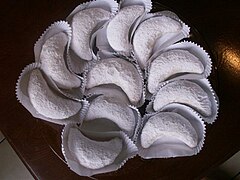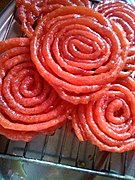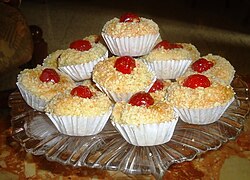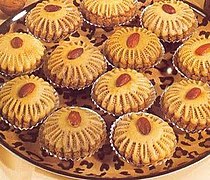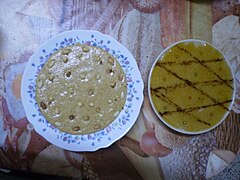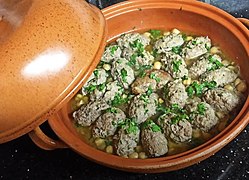Cookbook:Cuisine of Algeria
Cookbook | Ingredients | Cuisines | African Cuisines
Algerian cuisine is a Mediterranean and North African cuisine with Berber roots, known for its diverse variety of dishes thanks to the various interactions Algeria went through throughout the centuries. In addition to that, Algeria's large and diverse territory is able to provide both land and sea products.
Influences[edit | edit source]
The cuisine of Algeria has a mix of Berber, Arab, Turkish, Andalusian, French, and Spanish influences. The Berber population in the region's early history introduced wheat and fruit cultivation. They developed couscous, which has become the national dish and staple item, and they also influenced Algerian stews and tagines. Muslim Arab invaders around 600 AD introduced a variety of flavorings from the East, such as saffron, nutmeg, clove, ginger, and orange flower water. Turkish and Ottoman influences on Algerian cuisine include a variety of pastries, fruits, nuts, and flavorings. The French occupation of Algeria in the 19th century introduced new culinary features, especially in terms of bread and a variety of pastries. They also introduced a variety of foods originally from the Americas.
Characteristics[edit | edit source]
Sauces[edit | edit source]
A variety of sauces are used in Algerian cuisine. These include:
- Marqa beida (derdja): white sauce made with butter or oil, seasoned with onion, black pepper, cinnamon, ginger, saffron, and/or turmeric
- M'hammer (roasting sauce): butter-based sauce with onion, cinnamon, and saffron
- Dersa (red sauce): red pepper sauce, containing black pepper and cinnamon
- Marqa b'tomatich: tomato-based sauce containing onions, garlic, black pepper, cumin, and other flavorings
- Chermoula: acidic sauce often used for marinating meats
- Marqa helou: sweet butter-based sauce including cinnamon, saffron, and honey

Couscous[edit | edit source]
Couscous is a staple food and national dish in Algeria, originating with the original Berber population. It is technically a type of pasta, made of a semolina dough crumbled into small grains and cooked until fluffy. It's traditionally steamed in a taseksut (also called kaskas or couscoussier) and can be served savory or sweet.
Bread[edit | edit source]
Algerian breads are eaten at most meals, where they are often used to scoop and soak up foods. They can include the following types:
- Khubz ad-dâr ("bread of the house"): round, yeasted wheat flatbread, baked in an oven
- Matlû or khubz at-tajîn: yeasted flatbread made of semolina, barley, sorghum, and/or corn; cooked on a heated surface like a hot plate
- Raqâq, rfîs, khubz-ftir, or tarîd: very thin, unleavened flatbreads, cooked on sheet of hot metal; often stuffed, can be sweet or savory
- French bread (pain): white, leavened, crusty french bread
Sweets[edit | edit source]
Algerian sweets include a variety of pastries that have been influenced by Arab, Ottoman, and Turkish cuisines:
- Ketaef or kadayif: pastry similar to konafa and other such pastries across the Middle East; consists of almond paste filling surrounded by a shredded semolina dough
- Madeleine aux amandes: molded cakes with an almond filling similar to frangipane
- Tamina: semolina cake with honey, cinnamon, and orange flower water
- Baqlawa: Algerian version of baklava; layered pastry filled with pistachios, almonds, and walnuts, and a perfumed syrup
- Samsa: fried triangular pastry filled with nuts and honey
- Algerian sweets
-
Tcharak, Algerian horn-shaped cookies
-
Algerian version of zlabia
-
Kaak
-
Mekrout el koucha
-
Mchewek
-
Tcharek el ariane
-
Cigares
-
Griouech
-
Mchekla
-
Tamina
-
Samsa
-
Algerian baqlawa
-
Makrout ellouz, an Algerian pastry made using almonds, sugar and lemon
-
Mkhabez
-
Kaak nekkash, an Algerian pastry stuffed with date paste and perfumed with orange flower water
Beverages[edit | edit source]
Coffee in Algeria is typically served strong. Tea is very popular and is often served with mint. Fruit juices are also widely consumed, as well as fruit/nut-flavored drinks called sharbats. Both goat and cow milk are available, and they are used to make the drink sahlab
Common ingredients[edit | edit source]
Vegetables[edit | edit source]
Fruit and nuts[edit | edit source]
Meat[edit | edit source]
Grains[edit | edit source]
Seasonings[edit | edit source]
Cinnamon, cumin, mint, marjoram, caraway, coriander, black pepper, chili pepper, ras el hanout, harrissa, baharat
Customs[edit | edit source]
Due to the high prevalence of Islam, Algerian cooking is almost always halal. Food is often eaten with three fingers of the right hand. Hospitality is widespread, and sharing of food and drink is common.
Gallery[edit | edit source]
-
Algerian dobara
-
Algerian mtewem
-
Halwet tabaa
-
Algerian rechta from Algiers
-
Green pepper and tomato hmiss
-
Arbit
-
Algerian bourek
-
Batata chtitha
-
Algerian tajine zitoun with chicken and meatballs
-
Traditional Algerian dish caleed yahne made of chicken fritters and a spicy sauce
Recipes[edit | edit source]
Dishes[edit | edit source]
Side dishes[edit | edit source]
Street food[edit | edit source]
Breads[edit | edit source]
- Kesra/Agrouhm (كسرة)
- Msemmen (مسمن)
- Matlouh (المطلوع)
- Khobz el Dar (خبز الدار)
- Mbesses
- Taguella
- Chrik
- Tamtunt
- Lamouna
- Mtabga
Desserts[edit | edit source]
- Tamina (الطمينة)
- Sfenj (السفنج)
- Baghrir (البغرير)
- Heart of Almonds (قلب اللوز)
- Mouskoutchou
- Tachrek
- Makrout
Beverages[edit | edit source]
- Orange Blossom Cherbet (شربات ماء زهر)
- Algerian Lemonade (شربات القارص)
- Algerian Mint Tea (أتاي جزائري)
- Mazagran (مزغران)
- Anise Syrup (حبة حلاوة)
- Sahara Date Milk (حليب التمر)
- Cherbet Meliana (شربات مليانة)
- Lekhchef (الخشاف)
- Verbena Remedy Tea (شاي ماء لويزة)
- Kahwa Zazwa
- Ouazouaza (الوازوازة)
- El Bared (البارد)
- Maâjoun el Heroor (معجون الحرور)
- Mocha with Goat Milk
- Takerouayet
